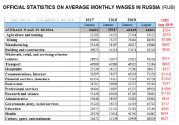How would the other 90% (artillery and mines) be addressed? How could Russia have done tank operations better?
It's not just Russian tanks. All types of vehicles from both Russian and Ukrainian forces are subject to this distribution. It's what full-spectrum peer warfare looks like in reality. Desert Storm was an exception.
The question should be what Russia could have done differently to avoid losing ~2000 MBTs, ~3500 IFVs and APCs, over 3000 of other vehicles, ~600 pieces of artillery and more. And the answer to that is
not invade.
Proof:
A. Tactical consideration:
- Armour is destroyed by artillery if it can't maintain maneuver.
- Armour can't maintain maneuver if it doesn't have infantry support for screening and recon.
B. Strategic consideration:
- Conscripts in Russia are barred by law from serving outside of Russia's territory.
- Because SMO takes place on territory of another country Russia has to invade using only contract personnel.
TMB2021 gives total of 900k (100%) service personnel:
- Ground Forces 280k (31,1%)
- Navy 150k (16,7%)
- Aerospace Forces 165k (18,3%)
- Airborne 45k (5%)
- Strategic Rocket Troops 50k (5,5%)
- SOF 1k
- Railway 29k (3,3%)
- Command & Support 180k (20%)
In Dec 2018 there was 384k contract enlisted with the administrative goal of 405k. 31% of that is 119,5k.
Before the 2008 reform of Serdyukov Russia had 350k officers and 140k warrant officers and those were to be reduced to 150k and 0 respectively. It didn't work. In 2009 there was 220k officers, and the reform was aggressively resisted leading to dismissal of Serdyukov in 2012. If we assume number of officers between 150k and 300k it gives proportion of 16,7-33%of the structure so 46,8-93,6k officers in the GF which leaves 187-233k for all conscript and contract enlisted and 119,5k contract available (31% of total). So at (unrealistic) best GF have ~2/3 enlisted on contract (119/187) and probably just around 50% (119/233). That 50% of enlisted are all "NCO" positions and only some of them will be privates. "NCO" positions usually take up 30-45% of modern military so if in RuGF officers constitute 25% of personnel and "NCOs" another 30% then it leaves almost half of the force for conscripts.
Those conscripts constitute e.g the majority of infantry dismounts in mechanized platoons.
And that calculation shows why on 24th of February Russia invaded Ukraine with tanks without infantry support and with minimal logistics and why before mobilization was announced there were news of sending sailors and cooks from Northern Fleet etc to Ukraine as they were on contract.
According to General Staff RuGF had 2 of each 3 regimental battalions staffed by contract personnel sufficiently to field a BTG. That was a lie because due to those problems with ranks, positions and staffing most regiments and brigades could only reliably field
one BTG from their structure if it had to rely on contract personnel exclusively.
Each Ukrainian regular brigade had 4 regular and 1 territorial/light battalion at full complement while each Russian regiment only had 1 BTG and only DPR/LPR forces had close to full complement.
Therefore it didn't matter that the paper strength of total invasion force was 2-3x that of Ukrainie beause in reality Ukrainian forces outnumbered the invaders, even without full mobilization. Even if Russia ordered full mobilization they would still have a limited pool of contract troops to draw on as they legally couldn't force conscripts to fight.
Russian reserve that was available for SMO was limited to former contract personnel.
The reason why Russia annexed the four oblasts of Ukraine on
30 September 2022 was to enable legal use of
mobilized conscripts in Ukraine on what would constitute Russian territory under Russian law. Partial mobilization was announced in Russia on
21 September 2022.
This was well understood by the Ukrainian General Staff which is why they decided to fight. While western media point to high morale and determination it was
pure cold tactical and strategic calculation:
Ukraine had the numbers and Russia didn't and therefore Russia couldn't win on the battlefield. All Ukraine had to do was to survive the shock of first 3-4 days to complete mobilization of active units which was extremely probable. Only complete collapse of political leadership could prevent effective resistance and that couldn't be achieved simply by eliminating Zelensky.
The shortage of personnel was also systemic because Russia couldn't afford more contract troops. So the failure of 2022 couldn't be averted with more preparation because exactly
the same internal political pressure from the cadre that prevented Serdyukov's reform and establishment of fully contract rapid reaction units would prevent any short-term build-up of contract personnel. It had to be long-term transformation and that lay beyond Russia's ability.
According to SIPRI Russia spending on defence as % of GDP was:
- 2020 - 4,3%
- 2019 - 3,8%
- 2018 - 3,7%
- 2017 - 4,2% (revised National Armaments Program 2018-2027)
- 2016 - 5,4%
- 2015 - 4,9%
- 2014 - 4,1% (temporary GDP reduction due to sanctions)
- 2013 - 3,9%
- 2012 - 3,7%
- 2011 - 3,4%
- 2010 - 3,6% (new National Armaments Program)
- 2009 - 3,9% (temporary GDP reduction due to crisis)
- 2008 - 3,1%
The lowest monthly pay for contract private in 2017 was slightly above 20k rubles or $600/300 at 2013/2017 exchange rate. The average monthly wage in 2017 was ~35k rubles, and in most industries it was 30k. So it's not really competitive outside of the poorest regions of Russia.


Russia's failure in Ukraine came as a surprise only to people who didn't know the above - all of which was public information, if not common knowledge.
And these are results of trying to wage combined-arms warfare against rules of combined-arms warfare:
Russians already tried doing it in Grozny and learnt nothing apparently. Or perhaps forgot.
It is possible that the proportion of Russian to Ukrainian equipment losses corresponds with the proportion of active personnel being used on combat operations. Those losses stopped as soon as the numbers of soldiers equalized in late 2022. So far I do not have good proof for that, just a solid conjecture.


